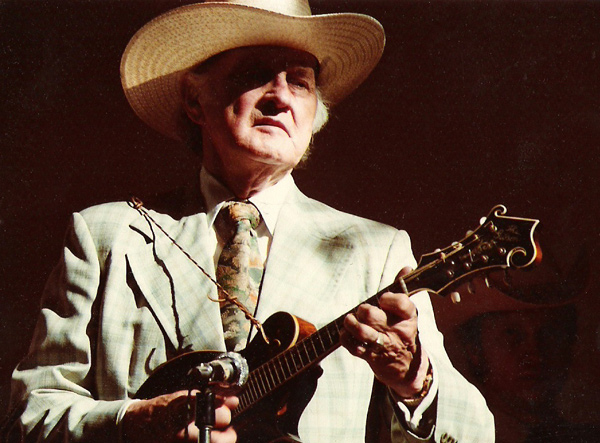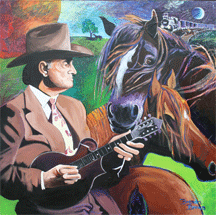A Bill Monroe Centennial Moment
‘We Really Put On The Dog’
In a single stroke in 1939, Bill Monroe established a signature song and a signature sound on the night he joined the Grand Ole Opry
(Ed. Note: Nothing against Ronald Reagan--well, maybe a few things--but TheBluegrassSpecial.com feels the far more important centennial to celebrate this year is that of Bill Monroe, the Father of Bluegrass, who would have turned 100 on September 13. Mr. Bill is such a giant of American music that we are honoring his 100th birthday with a Bill Monroe Centennial Moment each month throughout 2011. Sometimes these will take the form of accounts of Monroe's influence on succeeding generations of musicians--as in last month's installment of how young Carl Perkins's discovery of Bill Monroe's music helped him develop the rockabilly rhythm he perfected in the honky tonks around Jackson, TN; someetimes we will look back at a signal moment in the artist's life, as we do this month in chronicling his first appearance on the Grand Ole Opry, a game changing moment for Bill Monroe and for country music. We are also in the process of commissioning other artists to contribute their thoughts on Monroe's impact, on their work and/or on music in general. We feel it's the only fitting and proper way to honor a great American original.)
One late October day in 1939, a tall, powerfully built Kentuckian strode confidently into the lobby of the National Life and Accident Insurance Company in Nashville, Tennessee.
He was looking for the man in charge of radio station WSM, whose studios occupied the National Life Building’s 11th floor. The country bandleader had been playing local or regional Carolina stations and now felt ready for the Grand Ole Opry, heard each Saturday night over WSM’s 50,000 watt signal. Thanks to the station’s transmitter strength and state of the art tower, a clear channel from interference by other stations, and Nashville’s central location, the Opry boomed into cities, towns and farms from the Rocky Mountains to the Atlantic Ocean. Even if he never worked the show’s NBC network segment, first carried on a 26-station web less than two weeks before this singer and his group arrived in town, any spot in the lineup afforded the broad exposure every radio professional coveted. Besides, the musician said later, “WSM had the same initials I have. That’s William Smith Monroe.
“When I got there,” Bill Monroe continued, “the three men who ran the Opry—Harry Stone, the Solemn Old Judge (George D. Hay) and David Stone—was going out for coffee. I introduced myself to them, and they said they would listen to me when they got back.” Cleo Davis, then guitar player for Monroe’s Blue Grass Boys, recalled the audition vividly. “They put us in one of the studios, and we really put on the dog. We started out with ‘Foggy Mountain Top,’ then Bill and I did a duet tune with a duet yodel, fast as white lightning. We came back with ‘Muleskinner Blues’ and ‘Fire on the Mountain,’ and I think that really sewed it up.”
Bill Monroe, Pt. 1: Faith, Family, Uncle Pen, The Coming of the Steel Rail and the Roots of BluegrassThe WSM executives liked what they heard. Monroe’s exciting, high-energy sound was at once familiar and new, rooted in traditional Southeastern string band music, yet distinctive and surprising. His intense, high-pitched voice and dexterous mandolin playing marked him as a born showman, and his erect bearing radiated dignity and authority. In short, he had star power, and star power was what the Stone brothers wanted.
Harry Stone, who had replaced Opry founder George D. Hay as station manager in 1932, was facing stiff competition from Chicago’s WLS National Barn Dance, WLW’s Boone County Jamboree in Cincinnati, and similar radio shows. To win advertising accounts and improve National Life’s visibility. Stone and his brother David, head of WSM’s booking department, were having full-time performers like Pee Wee King (1937) and Roy Acuff (1938), whose stage presence and musicianship surpassed what the Opry’s semi-professional hoedown bands could offer. Hay, who still hosted the show, resisted this star system, but he took sick leaves with increasing frequency and no longer called the shots. And Monroe’s folk-rooted music suited him just fine. “They told me I could go to work on that [coming] Saturday night,” Monroe remembered, “and if I ever left, I would have to fire myself.”
On October 18, 1939, Monroe made his Grand Ole Opry debut at Nashville’s Tennessee War Memorial Auditorium. He shared the stage with Jack Shook’s Missouri Mountaineers, three of whom doubled as a WSM pop act; Pee Wee King’s Golden West Cowboys, a flashy pop-western group; Uncle Dave Macon, a rollicking vaudeville trouper; Roy Acuff, already making a name for himself with “Great Speckled Bird”; the Possum Hunters and the Fruit Jar Drinkers, two old-time string bands; country-gospel crooner Ford Rush; and harmonica wizard DeFord Bailey, country music’s first black star.
Bill Monroe, Pt. 2: The African-American tradition and the Roots of Bluegrass. This segment features a complete live performance of ‘Muleskinner Blues.’It was a formidable roster, but Monroe was self-assured. “I wasn’t a bit negative,” he recalled. “I had my music up to where I knew that I could control it. The first night that I was there I sang ‘Muleskinner Blues,’ and I got three encores for it.” In one stroke, he had established a signature song and an identifiable sound.
Monroe’s crowd pleasing Opry performance landed him his first guest shot on the program’s NBC network segment, on November 25. Sponsored by the R.J. Reynolds Tobacco Company, the half-hour “Prince Albert Show” advertised Prince Albert Smoking Tobacco, the “national joy smoke.” Roy Acuff was the headliner, but guest spots could work wonders for an artist plugging show dates and selling songbooks or records.
For his network radio debut, Monroe stuck with his updated version of “Muleskinner Blues,” earlier a hit for country recording star Jimmie Rodgers. The new rendition had worked for Monroe in his recent Carolina-area shows and it worked again that night. His handling of Rodgers’ song is audacious—even a trifle irreverent. Monroe sings higher and faster than Rodgers, lending energy and brilliance to the performance. “I wanted to have a different yodel from what he had,” Monroe added. “It’s got a little laugh on the end of it. …When I seen that it would sell—that little yodel would help sell the number—I knew that we had something going that would be to my advantage on down through the years.”
Art Weston’s enthusiastic fiddling and Amos Garren’s walking bass lines further enliven this number, as do the tooting sounds Judge Hay makes on his famous “steamboat” whistle. Most important, however, is Monroe’s noticeable emphasis on the beat. He and his brother Charlie, a popular duet who had parted ways in 1938, had sometimes rushed their songs; what Bill Monroe wanted was rhythm, not speed alone. Although he usually propelled his music with his mandolin, here he trades instruments with guitarist Cleo Davis. Interestingly, Monroe includes a G run, probably borrowed from his guitar playing brother. The riff is often called the “Lester Flatt G run,” after Monroe’s well-known guitarist of the late 1940s. But the credit for introducing it into what became bluegrass belong to Monroe himself.
1-03 Muleskinner Blues [Live]
Bill Monroe and the Blue Grass Boys perform ‘Muleskinner Blues’ on their 1939 network radio debut on NBC’s ‘Prince Albert Show,’ sponsored by ‘the national joy smoke,’ Prince Albert Smoking Tobacco. ‘The beat in my music—bluegrass music—started when I ran across ‘Muleskinner Blues’ and started playing that,’ Monroe said.The bandmaster has long identified “Muleskinner” as the touchstone for bluegrass. “The beat in my music—bluegrass music—started when I ran across ‘Muleskinner Blues’ and started playing that.” True enough, but in 1939 no one was calling Monroe’s music by that name. He was then intent upon shaping a distinctive personal sound within the country music world, not a new popular art form with a life of its own. As it turned out, though, he became the fountainhead for a style now performed by professional and amateur bands around the globe.
(Excerpted from the introduction of John W. Rumble’s essay/biography of Bill Monroe accompanying the 1994 four-CD box set, The Music of Bill Monroe from 1936 to 1994)
Now out of print, The Music of Bill Monroe from 1936 to 1994 is available from sellers at www.amazon.com. A pricey proposition, but still the most thorough domestic overview available, this four-CD box contains seven decades of recordings Monroe made for RCA, Columbia and Decca/MCA. Pretty simple: this is the master at work, over time, and the end result of listening to these discs chronologically is to be amazed both by the consistency of his music and by the musicians’ unflagging commitment to bridging technique and heart. Mr. Bill did it right, and he did himself, his Bluegrass Boys, and his music proud in the process.
***
Art Inspired by Bill Monroe On Exhibit and For Sale at International Bluegrass Museum
The Clash of Molly and Tenbrooks, acrylic on canvas, 42” x 42,” by Brenda Brown, Russellville, KY; inspired by ‘Molly and Tenbrooks.’ $1000. The song that inspired Ms. Brown’s painting was recorded by Bill Monroe and His Blue Grass Boys on October 28, 1947 and is based on a 19th Century horse race between California mare Mollie McCarty and Kentucky’s Ten Broeck on July 4, 1878 at the Louisville Jockey Club (now the fabled Churchill Downs).At the International Bluegrasss Museum in Owensboro, KY, now through September 15, is a display of art inspired by Bill Monroe’s music, sponsored by an Arts Build Communities grant through the Kentucky Arts Council
This Exhibit is the result of an invitation to visual artists to share their interpretation of a Bill Monroe song. Bill Monroe often painted images with his music and in this Exhibit artists have depicted their versions of these same images visually. Thirty-five artists responded to the invitation, with over sixty entries. The entries encompass many styles, from fine art to folk art. This is representative of the wide variety of people to whom Bill Monroe's music appeals.
Most of the works of art submitted were inspired by the lyrics of a Bill Monroe song, while some were inspired by instrumentals; some were inspired by songs Monroe wrote, others by songs from other sources that Monroe covered and stamped as uniquely his.
‘In the Pines,’ inspired by the traditional American folk song that has been traced to the 1870s. It was recorded by Bill Monroe and His Blue Grass Boys twice, in 1941 and 1952; Lead Belly was the song’s foremost practitioner, cutting it half a dozen times (under the title ‘Where Did You Sleep Last Night’) between 1944 and 1948. This acrylic on canvas painting (30” by 40”) is by Diane Wible of Owensboro, KY, and is priced at $650.
The pieces of art selected for the Exhibit are listed in this catalog in alphabetical order by artist. All the art on display in the Exhibit is available for purchase at the prices listed. Sixty percent of the proceeds will go to the artist and forty percent will go to the Museum. If you are interested in purchasing any of the artwork please contact Forrest Roberts at forrest@bluegrassmuseum.org.
For more information on the Bill Monroe Centennial celebration festivities at the International Bluegrass Museum, visit the Museum website, and please make a donation to support its worthy effort to document the history and evolution of bluegrass and to promote the music to new generations.
Founder/Publisher/Editor: David McGee
Contributing Editors: Billy Altman, Laura Fissinger, Christopher Hill, Derk Richardson
Logo Design: John Mendelsohn (www.johnmendelsohn.com)
Website Design: Kieran McGee (www.kieranmcgee.com)
Staff Photographers: Audrey Harrod (Louisville, KY; www.flickr.com/audreyharrod), Alicia Zappier (New York)
E-mail: thebluegrassspecial@gmail.com
Mailing Address: David McGee, 201 W. 85 St.—5B, New York, NY 10024




